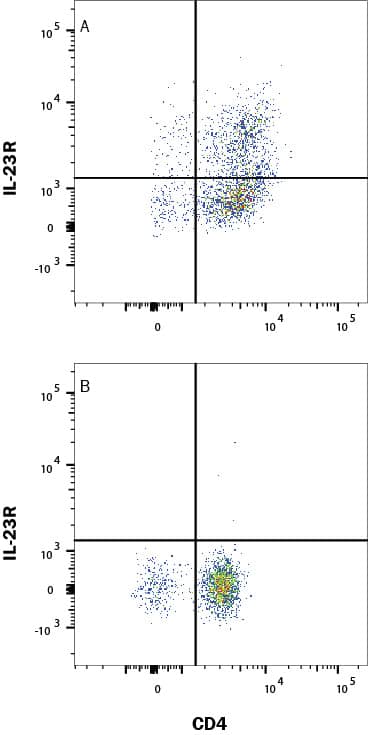Human IL-23R PE-conjugated Antibody
R&D Systems, part of Bio-Techne | Catalog # FAB14001P


Key Product Details
Species Reactivity
Validated:
Cited:
Applications
Validated:
Cited:
Label
Antibody Source
Product Specifications
Immunogen
Gly24-Ile354
Accession # Q5VWK5
Specificity
Clonality
Host
Isotype
Scientific Data Images for Human IL-23R PE-conjugated Antibody
Detection of IL‑23 R in Human PBMCs by Flow Cytometry.
Human peripheral blood mononuclear cells (PBMCs) (A) cultured with plate-bound 5 μg/mL anti-Human CD3, 2 μg/mL anti-Human CD28 (AF-342-PB), 20 ng/mL Recombinant Human IL-2 (202-GMP), 10 ng/mL TGF-beta (100-B), 20 ng/mL Recombinant Human IL-23 (1290-IL), 40 ng/mL Recombinant Human IL-6 (206-IL), 10 ng/mL Recombinant Human IL-1 beta (201-LB), and 10 μg/mL anti-Human IFN-gamma (AF-285-NA) for 7 days to induce Th17 development or (B) resting, were stained with Mouse Anti-Human CD4 APC-conjugated Monoclonal Antibody (FAB3791A) and Mouse Anti-Human IL-23 R PE-conjugated Monoclonal Antibody (Catalog # FAB14001P). Quadrant markers were set based on Mouse IgG2B Isotype Control (IC0041P). Staining was performed using our Staining Membrane-associated Proteins protocol.Detection of IL‑23 R in HEK293 cell line transfected with human IL-23 R by Flow Cytometry.
HEK293 human cell line transfected with human IL-23 R were stained with Mouse Anti-Human IL-23 R PE-conjugated Monoclonal Antibody (Catalog # FAB14001P, filled histogram) or Mouse IgG2B Isotype Control (IC0041P, open histogram). Staining was performed using our Staining Membrane-associated Proteins protocol.Applications for Human IL-23R PE-conjugated Antibody
Flow Cytometry
Sample: Human peripheral blood mononuclear cells (PBMCs) cultured with plate-bound 5 μg/mL anti-Human CD3, 2 μg/mL anti-Human CD28 (Catalog # AF-342-PB), 20 ng/mL Recombinant Human IL-2 (Catalog # 202-GMP), 10 ng/mL TGF-beta (Catalog # 100-B), 20 ng/mL Recombinant Human IL-23 (Catalog # 1290-IL), 40 ng/mL Recombinant Human IL-6 (Catalog # 206-IL), 10 ng/mL Recombinant Human IL-1 beta (Catalog # 201-LB), and 10 μg/mL anti-Human IFN-gamma (Catalog # AF-285-NA) for 7 days to induce Th17 differentiation, and HEK293 cell line transfected with human IL-23 R.
Reviewed Applications
Read 1 review rated 5 using FAB14001P in the following applications:
Formulation, Preparation, and Storage
Purification
Formulation
Shipping
Stability & Storage
- 12 months from date of receipt, 2 to 8 °C as supplied.
Background: IL-23R
Interleukin 23 (IL-23) is a heterodimeric cytokine composed of two disulfide-linked subunits, a p19 subunit that is unique to IL-23, and a p40 subunit that is shared with IL-12 (1 - 5). The functional IL-23 receptor complex consists of two receptor subunits, the IL-12 receptor beta 1 subunit (IL-12 R beta1) and the IL-23-specific receptor subunit (IL-23 R) (3). Human IL-23 R cDNA encodes a 629 aa type I transmembrane protein with a 23 aa residue signal peptide, a 330 aa residue extracellular domain, a 23 aa residue transmembrane domain and a 253 aa residue cytoplasmic region. IL-23 R shares structural features with the IL-12 R beta2, including an N-terminal Ig-like domain, two cytokine receptor domains and multiple glycosylation sites in the extracellular domain. IL-23 R lacks the three extracellular membrane-proximal fibronectin-type III domains present on IL-12 R beta2. IL-23 R has a WQPWS sequence in the transmembrane-proximal cytokine receptor domain similar to the cytokine receptor signature WSXWS motif. The cytoplasmic region of IL-23 R has three potential Src homology 2 domain-binding sites and two potential Stat-binding sites. The gene for human IL-23 R is located on human chromosome 1 within 150 kb of IL-12 R beta2. Human and mouse IL-23 R share 66% amino acid sequence identity. Based on quantitative real-time PCR, human IL-23 R mRNA is expressed in a human Th1 and Th0 clone as well as several NK cell lines and clones. Low but detectable levels of IL-23 R mRNA is also expressed in EBV-transformed B cells and activated PBMC. IL-23 initiates a signal transduction cascade similar to that of IL-12, and involves Jak2, Tyk2, Stat1, Stat3, Stat4, and Stat5. IL-23 has biological activities that are similar to, but distinct from IL-12.
References
- Oppmann, B. et al. (2000) Immunity 13:715.
- Lankford, C.S. and D.M. Frucht (2003) J. Leukoc. Biol. 73:49.
- Parham, C. et al. (2002) J. Immunol. 168:5448.
- Belladonna, M.L. et al. (2002) J. Immunol. 168:5448.
- Aggarwal, S. et al. (2003) J. Biol. Chem. 278:1910.
Long Name
Alternate Names
Gene Symbol
UniProt
Additional IL-23R Products
Product Documents for Human IL-23R PE-conjugated Antibody
Product Specific Notices for Human IL-23R PE-conjugated Antibody
For research use only
